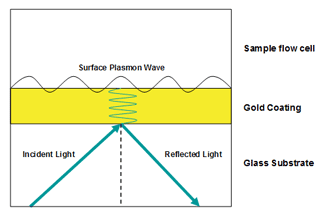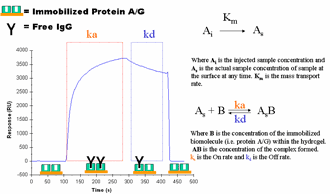In simplest terms, surface plasmon resonance is a technique for detecting changes in refractive index at the surface of a sensor. The sensor is comprised of a glass substrate and thin gold coating. Light passes through the substrate and is reflected off of the gold coating (Figure 1). At certain angles of incidence, a portion of the light energy couples through the gold coating and creates a surface plasmon wave at the sample and gold surface interface. The angle of incident light required to sustain the surface plasmon wave is very sensitive to changes in refractive index at the surface (due to mass change), and it is these changes that are used to monitor the association and dissociation of biomolecules.

Figure 1
The fully integrated SPR sensor used by Pioneer systems is a highly sensitive, static, and stable optical design. Light emitted by an LED passes through a polarizer and reflects off of the gold sensing surface. A detector array then measures the reflected light and calculates the angle at which light has coupled through the gold surface as an attenuation or dip in the signal.
As mass accumulates at the sensor surface during a binding interaction, the refractive index increases and an increase in signal is observed. After the sample is replaced by buffer, mass will decrease at the surface during the dissociation phase and with a subsequent decrease in the resonance unit response. By repeating this cycle at different concentrations, calculations can be made for ka (on-rate) and kd (off-rate) of the biomolecular interaction (Figure 2).

Figure 2